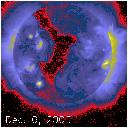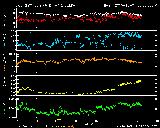
The name for this science nugget came from an e-mail message from solar scientist Todd Hoeksema - he and several other regular solar observers have been exclaiming about this beautiful structure (see some of the quotes from their various messages); here's an image from Yohkoh as it rotated past the center of the Sun:

The coronal hole is the chevron-shaped black area running vertically across the Sun, parting the corona much like Moses must have parted the Red Sea (this thought must have come from the image colors - we use these to show faint things, red and especially black, in the presence of bright things, blue and especially yellow).
The ACE (Advanced Composition Explorer) plots below show the high-speed flow from our gorgeous coronal hole:

The yellow plot, second from bottom, shows the wind speed picking up to the level of a "high-speed stream" (with a speed of 600 - 700 kilometers per second, it's not slow!) of the sort usually associated with a coronal hole.
The boundary of a nice coronal hole (like this one) seems quite sharply defined. Why not? On one side of the boundary, the coronal field (we presume) is open, meaning that it extends all the way from the solar photosphere into the solar wind, thence into the cosmos. On the other side, we have closed field lines trapping million-degree plasma that lets us see their conformation clearly. In the photosphere, though, convective motions, differential rotation, and other kinds of motion drag the footpoints of these field lines around. They must reconnect to each other as time passes, owing to these stresses, and the boundary of the coronal hole must evolve somehow. Although nobody has explored this evolution in detail yet (either here in this nugget or in the Yohkoh scientific literature, so far as we're aware, we get more than a hundred images per day of the quality shown above. Such a flood of data no doubt contains much information about the physics of the coronal-hole boundaries, both in quiet times and when flares or CMEs are happening. So there's an urgent need to learn what we can about the physics of the coronal-hole boundary, which has certain obscurely fascinating and yet ill-understood properties.

There is no obvious effect - the eastern and western boundaries of the hole appear equally fuzzy. This probably is not a very strong test, though; perhaps a reconnection signature would be more apparent in the temperature, a much harder observational tool. Or the systematic effects of projection (real world 3D; astronomers' view 2D) may obscure any effect. Or, we may have almost-parallel magnetic field lines on either side of the "separatrix" that divides open and closed fields, and reconnection in this case may not release much energy. (Note - the streaks across the image represent odd pixels of the CCD apparently drifting across the image as the Sun rotates. We've tracked the photospheric rotation to make this sum image.)
As expected, our quick looks at the data during this rotation of a "gorgeous coronal hole" across the solar disk did not lead to any great discoveries, even though there are major unknowns here. Not surprising - if there were obvious effects related to the opening and closing of coronal magnetic field lines, somebody would probably have reported them already. This science nugget is therefore more like an advertisement of discoveries to be made in the future, rather than a description of them!
December 15, 2000
Aki TAKEDA <takeda@isass0.solar.isas.ac.jp>